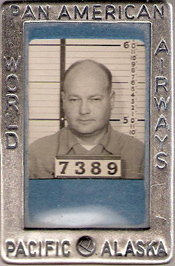|
Lee Willey brings to us a fundamental example of the skills, aptitudes and desires of
the kinds of pilots, both men and women, who flew in American airspace during the Golden Age through WWII and into the early post-war air transport industry.
This biography page with sixty images is complemented, courtesy of his family cited in the right sidebar, by the separate and comprehensive Lee Lysle Willey Photograph and Document Collection. The 84 photographs, certificates and documents in the Collection are categorized by boyhood, early career, Eastern Airlines, Rickenbacker correspondences and his military service during WWII. Please direct your browser to the link to explore each one.
With an education that did not include a high school diploma, he leveraged his flying skills into a career which included flying for five airline companies before and after WWII, and he multiplied his hard-earned knowledge across other aviators by serving as a flight training officer in WWII.
Along the way he brushed shoulders with some of the greats of aviation, including a good number of fellow signers of the Davis-Monthan Airfield Register.
This is a long and diverse page for one of the Register's most interesting and accomplished, yet little-known, pilots. Please give yourself enough time to absorb it all, and to imagine what his life was like. He led a wonderful one, which is captured in these images, newspaper articles and spectacular artifacts that are shared with us by his family. His life is further celebrated in his photograph and document collection.
Lee Willey, Age 2, 1904
 |
Lee Lysle Willey was born at Burlington, CO, July 17, 1902. He spent his early years at Delta and Grand Junction, CO, attending Delta High School and leaving after his sophomore year. He lived on a ranch in Colorado, riding horses. On June 10, 1921 he married Gladys Shropshire of Fruita, CO. They had a son, Selwyn Lee, born March 30, 1922. All of the information and photographs on this page are shared with us by his family (right sidebar).
Lee L. Willey, FAI License Photo, 1928
 |
He participated in most of the aviation activities available to committed aviators of the era. He barnstormed, raced, and flew pioneer air transport in the west. Based in India during WWII, he trained the pilots that would fly the high-altitude "Hump". He contracted the almost obligatory malaria while there. More recently his granddaughter tried to find an address where Lee and Gladys lived by an airport in California. As happens in many cases, neither home nor airport are any longer around. What does remain, through the articles, photos and artifacts below, is evidence of the skills and drive that made him a significant player in Golden Age aviation and beyond.
Lee Willey learned to fly in California in 1924. In that year, he operated a flying school with Jack
Frye and Paul
Richter, who had founded the Aero Corporation of California ("Aero"). The company's slogan was, “Guaranteed to solo for $250.” Willey was the chief instructor with five assistant pilots. Below, we see Willey second from left, holding helmet and goggles under his arm, with the founders of Aero identified below their likenesses (Richter, Frye and Hamilton). Richard Edwards was a pilot for Aero (see the news article of Aero pilots being sworn in as deputy sheriffs, below), but I know very little about him. Does anyone KNOW?.
Lee Willey with Aero Corporation of California Founders, Ca. Mid-1920s
 |
Lee Willey, Ca. 1927-28
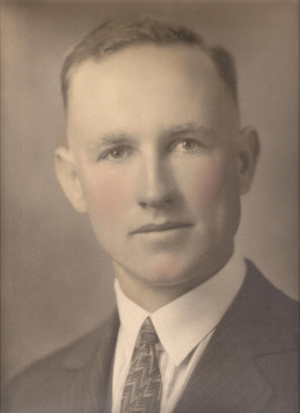 |
Note the pen stuck in Richter's right boot top. Note, too, the differences in high-top boots worn by Willey and Frye vs Richter and Hamilton. Whereas Richter and Hamilton's lace all the way up, the others's lace only at the instep. Direct your browser here to see similar vintage garb on your Webmaster. Note also the pilot wings on Frye (and also on Willey, but not so visible). Willey's insignia may be the same wings with us today, as they look very much like the design below.
Right, a more formal, colorized portrait of Willey, circa 1927-28. The colorization was performed by the original photographer. This is not a PhotoShop exercise by your Webmaster!
Willey trained students in the Curtiss JN-4 Jenny, Thomas-Morse Scout, SE-5 and Standard J-1, and the Alexander Eaglerock pictured, above. Aero also did crop dusting and was the West Coast distributor of Alexander Eaglerock aircraft. See the links to Frye and Richter for additional information about Aero, its physical plant, aircraft, and its operations.
Below, Lee Willey in front of Aero Corporation's Jenny. In the original image, the company livery can be read on the vertical tail surfaces. Date unknown, but probably late 1920s.
Lee Willey and Aero's Curtiss "Jenny"
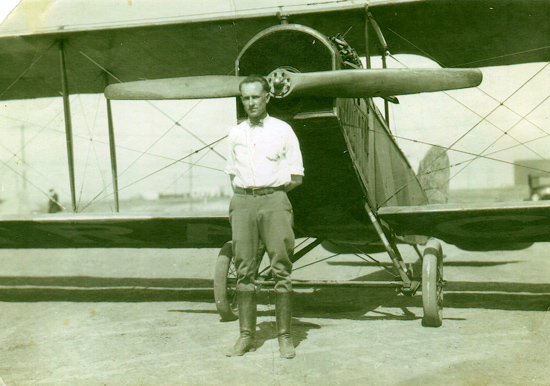 |
Below, some examples of his barnstorming, racing, and pioneer air transport experience. Immediately below, date unknown, three Register pilots barnstorm for the camera. Vance Breese is at top caught in a knife-edge maneuver. The Aero Jenny is at right and one of the Aero Eaglerocks is at left. Note what appears to be a T-hangar on the ground.
Barnstorming on a Knife-Edge in California
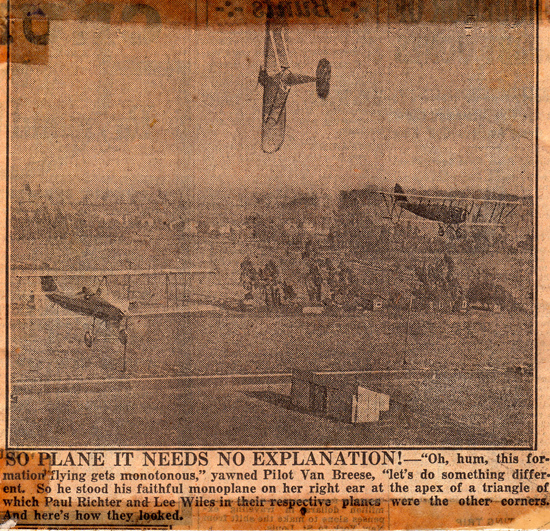 |
Below, in 1926, the Los Angeles County sheriff deputized five Aero pilots. To my knowledge, despite the fanfare, they never made or assisted in an arrest.
Aero Pilots Sworn in as Sheriff Deputies, 1926
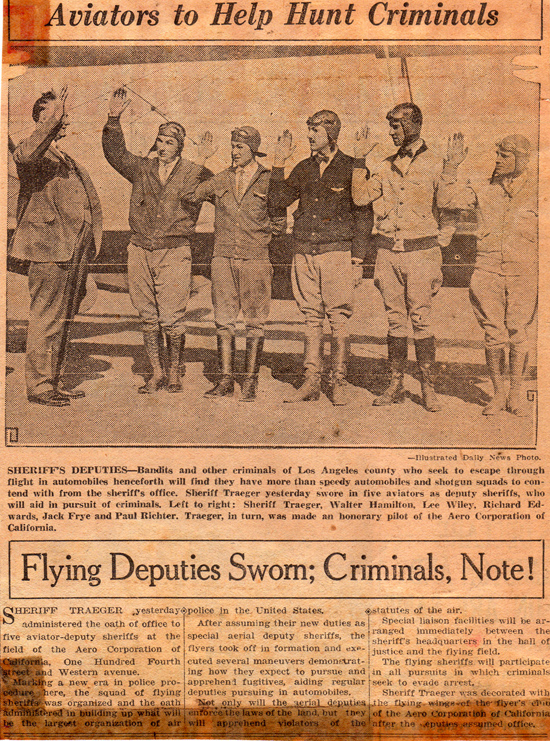 |
Below, two undated and unsourced news articles describing Willey's crop dusting activities. Chances are good that the airplane pictured at bottom is the Stearman, NR5310, flown by Willey to Tucson and cited in the Register. Note the "NR5xxx" under the wing.
Articles About Crop Dusting, Ca. 1929
 |
Dusting Article, Cappers Weekly, Date Unknown
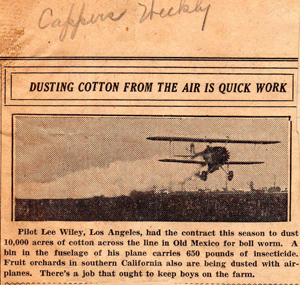 |
At right, a brief, undated article from Cappers Weekly, a news magazine still published in Kansas. This article, and the ones above, probably were printed sometime just before September-October, 1929. Those are the months Willey passed through Tucson with NR5310 on his way to and from the southern border and Mexico.
The microfilm record at the Kansas Historical Society for Cappers Weekly (published in Topeka, KS) for 1/5/29-12/27/30 is on film reel T2234. I have not researched this source, but include it here for anyone who may want to.
Lee Willey, FAI License, 1926
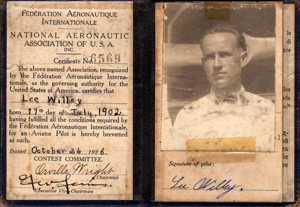 |
Lee Willey's FAI Certificate number was 6569 (left). He would be about 24 years old in the photograph. Note that the license was actually signed by Orville Wright (this is not a rubber stamp signature). After the Department of Commerce (DOC) began regulating pilot certification in 1926, he held license number 1068 (his 1930 DOC license is below). This is a pretty low number, with only a dozen or so pilots in the Register for whom I have numbers holding lower.
Fokker NC3317, California, Circa 1927-30
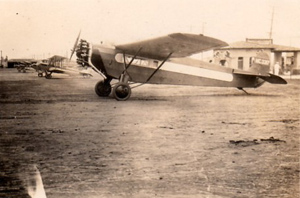 |
Lee Willey was a prolific visitor at Tucson. He signed the Register as pilot in command 44 times between December, 1927 and October, 1929. He flew only three aircraft: the open-cockpit Fokker Universals NC3317 (38 landings) and NC3193 (4 visits), and the Stearman C-3B NR5310 (2 landings). He also landed at least twice as a passenger, once with Jack Frye on Wednesday, December 28, 1927 and once with A.E. Cameron on Thursday, July 19, 1928. This last flight was in an Alexander Eaglerock, NC6846, and was identified in the remarks column of the Register as a "Ferry."
His last two visits to Tucson, in September and October, 1929, were in this Stearman. This airplane, c/n 127, was built as a C-2B, but redesignated as a C-3B. It was restricted for crop dusting, which was the purpose of Willey's last two missions along the border and down into Mexico.
The reason he landed so many times, was that he was a transport pilot for Standard
Air Lines (SAL), which was founded under the auspices of Aero Corporation of California in the late 1920s by Frye, Richter and Hamilton, pictured above.
Above right, Fokker Universal NC3317. Notice the open cockpit forward of the wing. The airplane is not painted in Aero Corporation or Standard Air Lines livery yet, so this may be an early photograph of it. There is an Alexander Eaglerock in the background, which is painted like the one below, but without the race number.
Lee Willey, FAI License, 1928
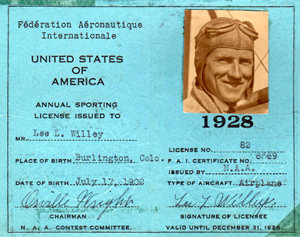 |
Willey, as a pilot of the line for Standard, shared flying duties with other Standard pilots such as Hap Russell, John Martin, Harold Kelsey and William Kingsley, as well as Jack Frye and Paul Richter. Refer to the link for Standard Air Lines, above, for details on the dates of service, route schedules and an economic analysis of the Standard Air Lines business. At left, his annual sporting license issued by the FAI for 1928. This license would have been in effect during most of his visits to Tucson. Note that it, too, was signed by Orville Wright.
Below, we see Willey standing beside 1671 (not a Register airplane). The airplane is a Long-Wing Alexander Eaglerock with OX-5 engine, serial number 259. The airplane is in Aero Corporation of California livery. Interestingly, the gentleman at right in the 3-piece suit is Jack Frye.
Lee Willey (L), Alexander Eaglerock 1671, Ca. 1927
 |
1927 National Air Races, Class "A" Status
 |
With reference to the Aircraft Yearbook for 1928 (page 485), we can date the Eaglerock image to 1927 (probably sometime in September), because Lee Willey, flying the airplane above, wearing race number 85, placed third in the Class "B" Pacific Coast Air Derby from San Francisco, CA to Spokane, WA. The Derby was one of the events staged during the 1927 National Air Races. His time was ten hours, 27 minutes and 28 seconds, barely a half-hour behind the winner, and a close nine minutes behind second place winner and Register pilot D.C. Warren. He won $250 for his effort. Given that Aero was an Eaglerock dealer, this race could be interpreted as advertising the business.
At right, a news article (circa September 20, 1927) that appears to have been continued from a previous column (this is all that Willey clipped, probably because it covered the Pacific Coast Derby).
In the article, we see Register pilots Vance Breese and Jack Frye (they took third and fourth place, respectively, in the Pacific Coast Class "A" Derby).
Headliner, Eddie Ballough, did finish second behind E.W. "Speed" Holman (not a Register pilot). He flew a Laird aircraft, NC7086, which he also flew in the 1928 Derby, New York to Los Angeles.
Register pilot Charles W. Meyers was competing in the other major Derby that year, the New York to Spokane race. He and his Waco did finish first with a time of 30:23:15. Meyers competed in the 1928 NAR and landed at Tucson in his Waco 10, NX5673 on September 11 and 22, 1928. Meyers finished 5th in the 1928 race. He was test pilot in charge of design-development at the Waco Aircraft Co.
Lee Willey, 1927 NAR
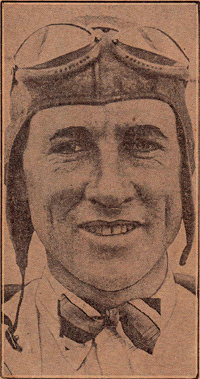 |
We also see note of Register pilots James Shelley Charles and the previously mentioned D.C. Warren. Like Meyers, Shelly also competed in the 1928 NAR.
At left, a news photo of Willey after his third-place finish in the 1927 San Francisco to Spokane race in the Aero Corporation's Eaglerock.
Below, a news image, probably dated September 20, 1927, sources the photograph and the news column above.
Los Angeles Illustrated Daily News, September 20, 1927
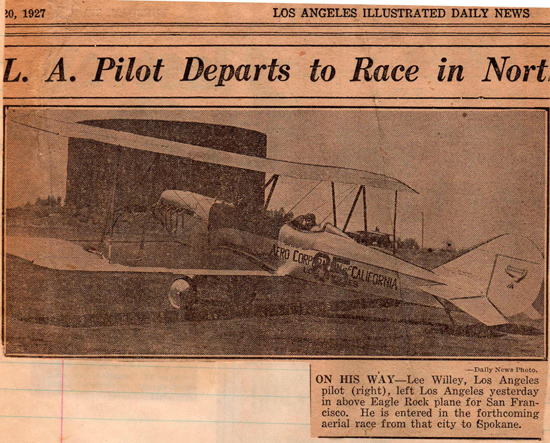 |
Below, another photograph with an Aero Eaglerock. At bottom right, the inscription says," Lee & Eaglerock at L.A." This may be the same airplane he raced to Spokane, because, just to the left of the crease down the center of the photo, upon enlargement, you can just make out the bottom of the "8" and the top of the "5" in his race number painted on the fuselage.
Lee Willey With Aero Eaglerock, Date Unknown
 |
An interesting thing about this image is that it is a photographer's proof. The photographer indicated "Proof" across the upper right wing. He then listed the prices for prints as follows: "All Prints 8 x 10, 75¢ for less than 6, $3.00 for 6; 5.00 [for] 12". His annotation was written with a nib pen and ink, as nib marks and gaps can be seen in the enlargement below.
Photographer's Price List
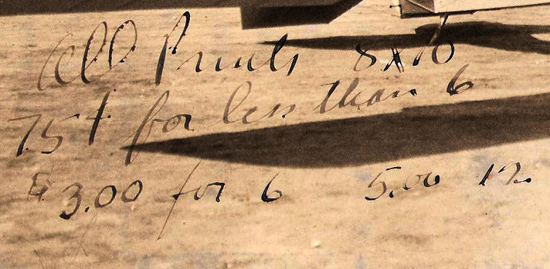 |
Below, another image of Willey, this time with an Aero Corporation of California Fokker (probably NC3317). The date of this image is unknown, but, if the ship is 3317, the date is sometime after November 23,
1927 when the airplane was purchased by Aero. Notice the little girl at right, the thickness of the wing root, and the taut fabric covering of the Fokker.
Lee Willey with Aero Corporation of California Fokker
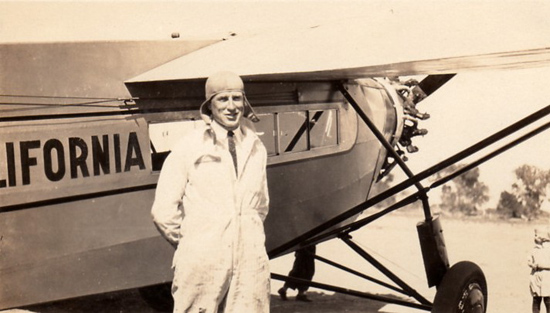 |
Below, a news article illustrating an early use of transport aircraft to move freight. The airplane is probably NC3317. For another example of freight carried by a Standard Air Lines Fokker, please direct your browser to NC9724.
Freight Carriage, Date Unknown, Location Probably Los Angeles, CA
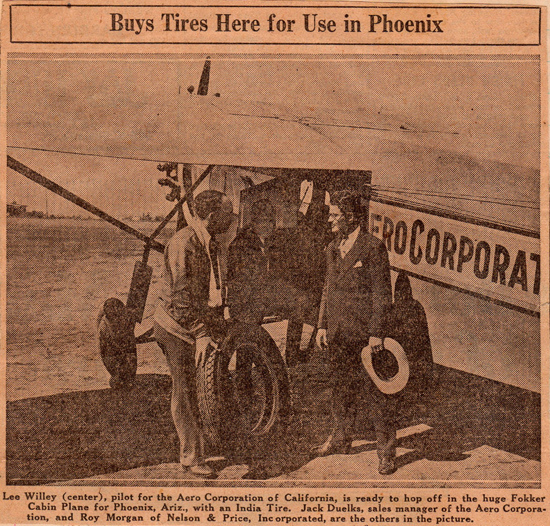 |
Freight Carriage, Undated Article
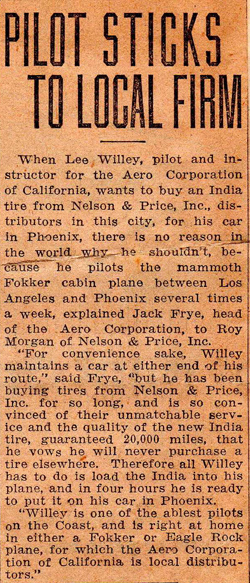 |
At left, the companion news article for the photograph above. What is commonplace in commercial aviation today was a big deal and highly newsworthy during the Golden Age. This news coverage served both Standard Air Lines and the tire company.
Besides air racing and pioneering air transport, Willey had a long and interesting life in aviation. Because of his granddaughter (right sidebar), we know that when he was young his height was 5’ 8-1/2” and that he weighed 147 lbs. His eyes were blue, hair brown and complexion fair.
His father was Luther Willey; mother Mable Keller Willey; and sister Nona (Vota/Barlow); brother Jack Willey, a pilot also (did not sign our Register), he was a flying Chief Petty Officer in the Navy and flew off the old Lexington before WWII. Then he flew for Pan American Grace in South America.
Goebel Flight
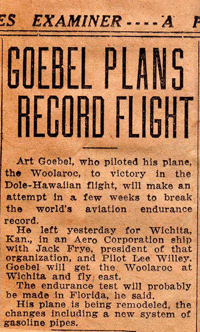 |
At right, an undated news article, probably from W.R. Hearst's Los Angeles Examiner, describing Art Goebel's travel on a Standard Air Lines Fokker with Lee Willey.
Coincidentally, in the Register we find Goebel as a passenger with Willey on Tuesday, February 7, 1928, eastbound from Los Angeles, CA.
Jack Frye was not listed among the passengers on this flight, and it appears that Goebel arranged for other means of transportation east, because Willey departed for Los Angeles the following morning, February 8, at 8:00AM.
Barely five months earlier, Goebel and his navigator William V. Davis, Jr., had won $25,000 by placing first in the prestigious Dole Race across the Pacific Ocean from Oakland, CA to Honolulu, T.H. Click on the link at left to view a book written about their trans-Pacific flight.
Goebel Flight
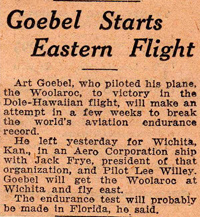 |
At right, another undated news article, probably of about the same date as the one above. Whereas the first article talks of "plans" to travel east, this one describes the beginning of that flight. The Woolaroc, Goebel's Travel Air 5000 trans-Pacific monoplane, did not make this flight, as the modifications to fuel tanks and other changes made it unstable.
Eaglerock Ferry, Undated
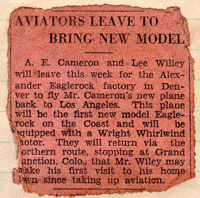 |
At left, this small "filler" article is remarkable for two reasons. First, it describes Lee Willey's aircraft sales-related responsibilities with Aero Corporation of California. Aero was the distributor of Alexander Eaglerock aircraft in California and Arizona. These aircraft were manufactured in Colorado Springs, CO and Willey and other Aero pilots routinely ferried new aircraft back and forth for their customers.
The second remarkable thing is that the transfer of this new Eaglerock is captured in the Register on Thursday, July 19, 1928. They apparently did not return (weather?), according to the article, "via the northern route." In fact, they remained in Tucson until the following Wednesday, July 25, 1928. Cameron noted in the Remarks column of the Register, "Ferry". The airplane was NC6846, C/N 569, an A-1 model with a Wright J-4 engine of 200HP.
Lindy Light Headline, Tucson Newspaper, Ca. March 14, 1928
 |
In the late 1920s, in local Tucson news, Willey is cited as "testing" the new Lindbergh Light at Tucson. In March, 1928 the so-called "Lindbergh Light" was inaugurated at the old Airfield to guide pilots approaching and departing at night. The light, actually, lights, consisted of a standard beacon for airfield identification, and flood lights for ground maneuvers. Three undated and unsourced articles in (probably) one of the local Tucson newspapers are available here. (PDF 2.4MB).
A little sleuthing identifies the date of these articles (headline, above right) as ca. March 14-16, 1928 and through the following week. The first article cites Ralph DePalma as a passenger traveling with Willey in a, "...big Fokker passenger plane" owned by Aero. According to the Register, which documents their visit, they landed at Tucson March 14th at 5:00PM. Amusingly, in none of these four articles will you find Willey's name spelled correctly, even once!
The second article cites local Tucson pilot Charlie Mayse as participating in the fine tuning of the lights. You will discover in the articles that Tucson Mayor John E. White passed away on March 15, 1928 just after the lighting ceremony. He was succeeded by Frank Cordis one of Willey's passengers during one of his flights to Tucson. The third article further documents lighting adjustments and recommendations made by Willey.
South Seas Plan, Undated
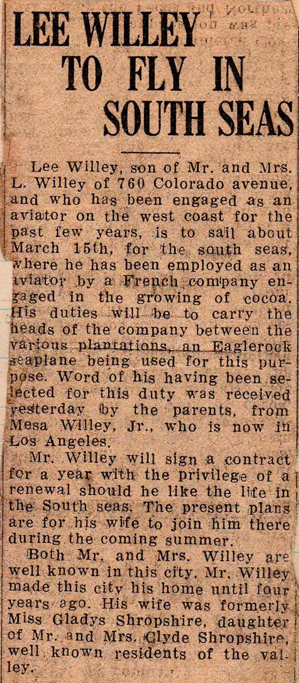 |
A year after his lighting tasks, on March 15, 1929, he set sail for Tahiti on a French visa. He was employed as a pilot by a French company, which grew cocoa, to carry executives to their plantations.
His job was supposed to last a year, with wife Gladys joining him once he was settled, but he stayed only through April.
At right, an unsourced and undated news article (but probably near 3/15/29) documenting his plans for the South Pacific.
Lee Willey, DOC License, 1930
 |
Above, is his DOC license, number 1068, issued on March 25, 1930 and revalidated through September 15, 1935. We see he had gained eight pounds! This license was authorized by Register signer Clarence M. Young (signature barely visible at bottom of the left-hand face of the license), holder of pilot license #2.
Let's step back a minute and place Lee Willey's early flying career in the social and political context of the time. He was in a job market clearly affected by the Great Depression. Not only that, the public had not yet fully accepted air transport as a "safe" mode of getting from one place to another.
Lee Willey, Mid-Continent Air Express, Ca. 1930
 |
In this yeasty social and business environment, Willey maintained his air transport career, begun in 1927 flying for Standard Air Lines. SAL, for whom he flew for the better part of its 28-month business life, was bought by Western Air Express (WAE) during July, 1930. WAE then combined with Transcontinental Air Transport (TAT) to become Transcontinental & Western Air (TWA) later in 1930. To complicate matters, WAE had acquired Mid-Continent Air Express (MAE) during 1929. Undated news article, below left, documents the absorption of Mid-Continent Air Express by Western Air Express.
Willey persevered in the face of this flurry of Depression-throttled acquisitions. He literally wore the hats of most of these airlines over that short period (approximately 1928-1934). We have these "hats" represented on this page. His SAL wings are visible on his jacket in a couple of the images above, and a bracelet made with them is below.
His Mid-Continent Air Express cap insignia is visible (albeit without a lot of detail) on his transport license, above, and in his portrait at right. His WAE and TWA insignia are also exhibited below.
At right, an original photograph of Lee Willey, ca. 1930, with cap insignia. From the NASM Web site, we can identify the insignia as that of Mid-Continent Air Express. Please follow the link to to the National Air & Space Museum's collection to see various Mid-Continent insignia, including the one on his cap shown below.
MAE Cap Insignia, NASM
 |
Please note that the NASM collection includes only this insignia for MAE. The rest of the insignia shown are for Mid-Continent Airlines, which had nothing to do with Mid-Continent Air Express. Express started on September 21, 1929 and flew between Denver, CO and El Paso, TX. The was absorbed by Western Air Express in 1931 as indicated below. Mid-Continent Airlines did not start up until 1938.
Now, below right, through the remarkable PhotoShop skills of Tim Kalina, comes this merge of the insignia at left with Willey's cap, above.
Lee Willey, Mid-Continent Air Express, Ca. 1930
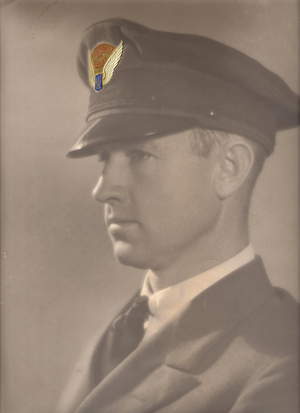 |
The cap insignia matches perfectly, and adds a surreal sense of color to this excellent sepia profile of the 28-year old airline captain shared with us by the Willey family.
WAE-Midcontinent Merger, Undated News Article
 |
As of July, 1931, he had accumulated well-over 3,500 flying hours. About 1934 (?) he took a job with Eastern, and from August 1934 to June 1942 he worked for Eastern Air Lines and Eddie Rickenbacker. He was a pilot and instrument flying instructor. On December 16, 1936, he flew the first Eastern plane into Houston, TX from New Orleans. The route was a former Wedell-Williams Air Service Corporation route bought on December 1, 1935 by Eastern. Captain Rickenbacker was aboard that flight. For an idea of what a cross-country journey was like in 1929, please direct your browser to this link to read an interesting narrative written by Rickenbacker about a trip he took with WAE.
During the 1930s, Willey was also an amateur photographer with his own darkroom. A number of his shots were used in newspapers. On April 6, 1936, a tornado destroyed Gainesville GA. Rickenbacker asked Lee to make an aerial survey. He took the first photos, which appeared in the New York Daily Mirror and Washington Herald. This link (PDF 2.5MB) downloads two news articles, ca. 1937, that describe his aerial photography activities. Later, during early 1942, Willey was the Operations Officer for the Georgia Civil Air Patrol Wing.
While working for Western Air Express, Willey was commended for his persistence in aiding in the location and rescue of a downed transport airplane and an injured passenger. The accident occurred September 8, 1932 and the following three letters document the appreciation shown by two airline companies of the era: Willey's employer Western Air, and American Airways, the owner of the crashed airplane.
American Airways Letter, September 21, 1932
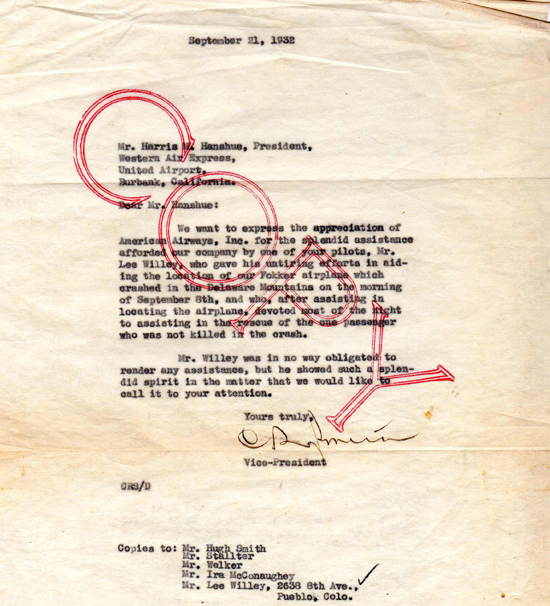 |
The Delaware Mountains are located in southwest Texas, east of El Paso, with peaks that reach over a mile high. We might conjecture the reason for Willey's perseverence in this search. His colleague from his Standard Airlines days, Harold Kelsey, was a victim of a similar crash near Calimesa, CA just six months earlier.
Western Air Express Letter, September 27, 1932
 |
Below, the third letter. This accident occurred near Salt Flat, TX. The American Airlines airplane was a Fokker F-10, NC9716, S/N 1009. It was enroute El Paso to Dallas, TX. At about 9:00 AM, the mail plane encountered poor weather, struck a mountain and burned. Of four people on board, only one survived, thanks to the efforts of Lee Willey.
Western Air Express Letter, October 4, 1932
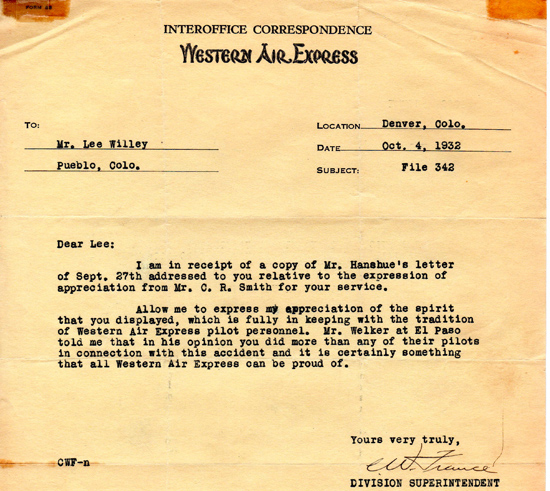 |
Below, courtesy of site visitor Bob Woodling, is a news article from the Big Spring (TX) Daily Herald that described the circumstances and aftermath of the crash. The article was headlined, "Plane Crashes in Texas Mountains; Three Die."
Daily Herald, Big Spring, TX, September 8, 1932 (Source: Woodling)
 |
We learn the pilot's name was W.J. Robbins. Neither Robbins of Everman, TX, nor copilot Francis Briggs of Dallas were Register signers.
Below, is the continuation of the article. Even though pilot Robbins was not a Register signer himself, we learn that he was taught to fly by Register pilot and endurance flyer Reg Robbins, a cousin. They barnstormed together before W.J. took a job with Texas Air Transport and then with American Airways.
Daily Herald, Big Spring, TX, September 8, 1932 (Source: Woodling)
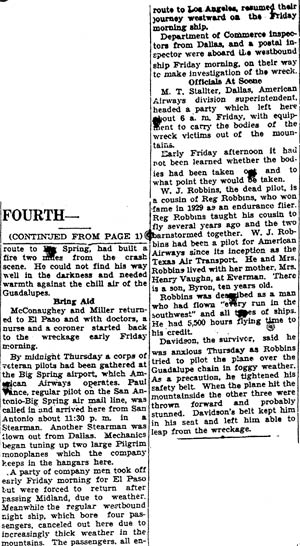 |
Willey's name is not mentioned in the article, although from the letters above it appears that his contributions to the best outcome possible in this glum situation were verifiable.
This article is testimony to the importance of seatbelts.
Below, excitement again entered the lives of Willey, his copilot, Albert Duke, and six passengers during a scheduled Eastern Airlines flight in a Curtiss Condor in 1935.
Newark Star-Eagle, August 9,1935
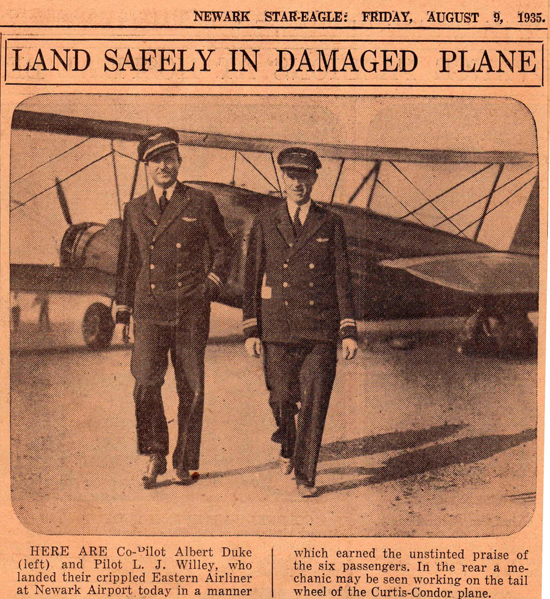 |
Additional press coverage of this incident is in the articles in this file (PDF 2.4MB). The newspaper names were not included with these articles. You'll note, again, the newspaper's inability to spell Willey's name correctly, and a few differences in details from article to article.
Below, an undated (late 1930s ?) image of a now unheard of amenity of early air transport in the U.S. It is a brochure introducing Eastern Captain Willey to the flying public. The first image is of the outside of the folded brochure, opened flat.
Eastern Air Lines, Pilot's Brochure
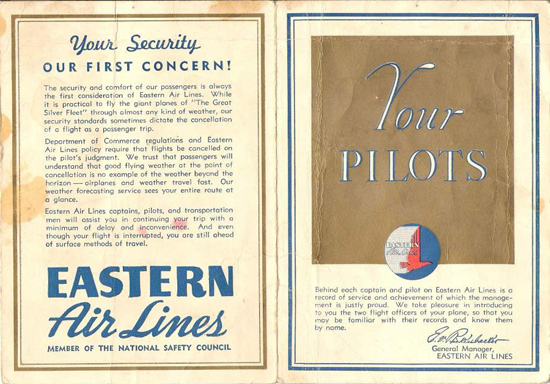 |
Below is the inside of the brochure, opened flat. Nowadays you might have the crew introduced by name over the public address system; no description of their qualifications.
Eastern Air Lines, Pilot's Brochure
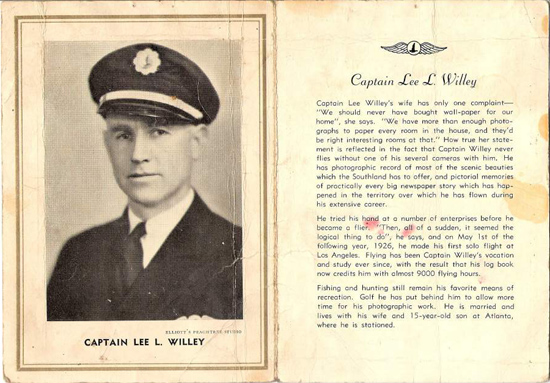 |
---o0o---
Lee Willey During WWII
 |
When WWII came, Lee Willey excelled in the Army Air Corps. He was commissioned Captain June 24, 1942 at Washington DC, soon after being awarded his Eastern Airlines 10-year pin by Rickenbacker in May 14, 1942 (which makes it possible that he worked from 1932 with Eastern Air Transport, just before Eastern Airlines was formed).
Because of the urgency of the war, he was brought in as a Captain due to his previous airline and CAP work, with no previous military experience. His grandson states that Willey had, "No previous military experience. It was a direct commission and took into account his hours and experience to that point in time. They put him directly into aircraft safety work at manufacturing locations."
A few days later on June 27th, he was rated service pilot, and until February 12, 1943 he worked in the Directorate of Flying Safety, Inglewood CA, and was the representative at West Coast plants making test flights and factory followups on each aircraft accident in which factory responsibility was probable (for C-54, B-24, and B-17 aircraft).
From October 16-18, 1942, he was admitted to Walter Reed Hospital for acute arthritis in his left 1st metatarsal. Despite this, on October 20, 1942 he was promoted to Major, and, on February 8, 1943 was rated Senior Pilot.
The Results of Malaria
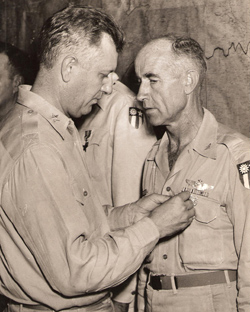 |
From February 12-June 1, 1943, he served as Flying Safety Officer, Flight Control Command, 2d AF, Winston-Salem NC. He demonstrated B-24s and B-17s including all emergency procedures and conducted accelerated service tests on new bombsight and autopilot systems.
On January 20, 1944, he was promoted to Lt. Colonel, while serving from November, 1943 to May, 1944 with the 20th Bombardment Squadron as check-pilot on B-29s.
On May 26, 1944, he departed the U.S. via Miami FL; San Juan, Puerto Rico; Trinidad; Natal, Brazil; Ascension Is.; Monrovia, Liberia; Dakar, French West Africa; Rabat, Morocco; Tunis, Tunisia; Tripoli, Libya; Cairo, Egypt; Baghdad, Iraq; Sharjah, Trucial Oman; India, arriving May 31, 1944.
From June 2, 1944 to September 12, 1944, he was stationed at HQ India China Division, Air Transport Command, as Flying Safety and Wing Rescue Officer, and Member of the Joint Flying Control Board, SE Asia Command. Under its auspices, he traveled to B-29 bases in China.
Below, a cover for the statistical report on Class 1944-A, probably the first class Willey was involved with upon his arrival in India.
Statistical Report, Class 1944-A, September, 1944
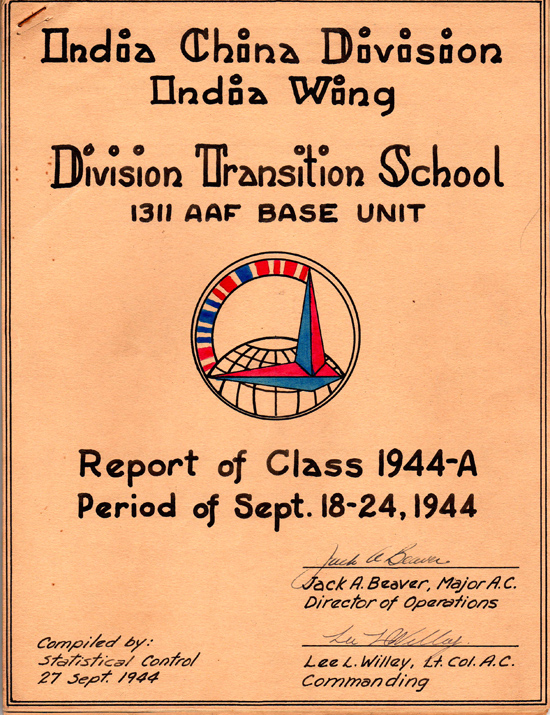 |
Air Transport Command Pin
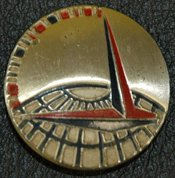 |
Lee Willey, Circa June, 1944
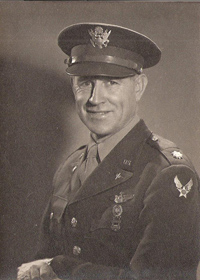 |
From September 12, 1944 to December 4, 1945, he was commanding officer of the 1311th Base Unit, Air Transport Command (ATC), India China Division, India Wing, Division Transition School, Gaya, India. At left is a small pin symbolizing the ATC.
A site visitor states about the small red and blue squares along the border of the ATC badge, "You will notice that all the WW2 ATC pin badges carry the same set of blue and red squares. ... [the pattern] represents a morse code sequence that spells out AFATC (Air Forces Air Transport Command). The alternative blue and red sequence of squares and rectangles allow each letter to be defined, for example the morse code is .- / ..-. / .- / - / -.-- / A square represents a DOT and a rectangle a DASH for the morse code. Unfortunately, this is not so clear on some badges as all the morse dots and dashes are indicated only by squares. But your badge shows the correct format."
Willey commanded the check-out school for pilots flying the Hump, including instrument flying over the Hump, and general aircraft handling at high altitudes. At this link, an article (2.7MB PDF) from the Hump Express of February 1, 1945, provides biographical information about Willey, the context for his command responsibilites in India, as well as a look at one of his passtimes while there. As of February 1, 1945 he had logged over 13,000 flying hours.
Below, another view of his favorite passtime. This tiger was killed March 17, 1945, on the estate of the Maharaja of Tikari. On July 1, 1945, he was promoted to Colonel.
Lee Willey and Asian Tiger, March 17, 1945
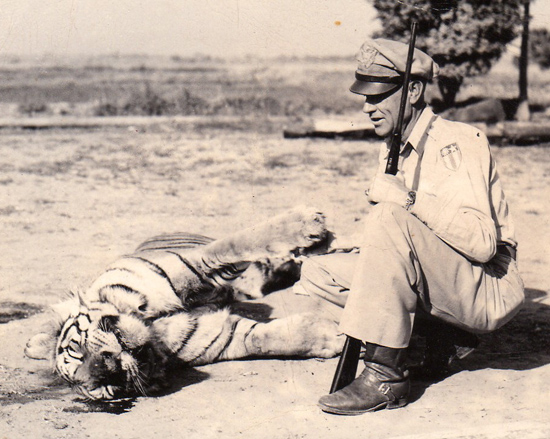 |
On August 12, 1945 he was awarded the Air Medal, pinned on by Register pilot and Brigadier General William Tunner. Below, the official letter awarding the Air Medal. Things were happening in Japan at this time! He was awarded a Bronze Star on October 5, 1945.
U.S. Air Medal Award, August 12, 1945
 |
Willey departed India on December 8, 1945. The best estimate of his homeward journey is: Aden; Khartoum, Anglo-Egyptian Sudan; Bourem(?), French West Africa; Accra, Gold Coast; Ascension Is; Natal, Brazil; Trinidad; San Juan, Puerto Rico; US. He arrived in the U.S. December 17, 1945. He had the tiger converted to a rug, as posed in the image below, with grandson and site contributor Scott (right sidebar). Sister Liz shares her feet in the background.
Scott Willey and Asian Tiger, Carmel, CA, 1963
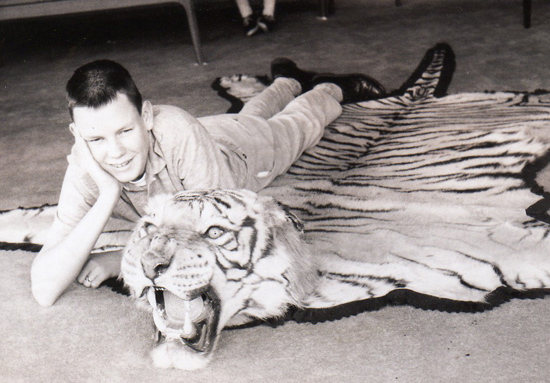 |
During early 1946 he was based at Headquarters, 594th AAFBU, 3d MAT Group, CDATC, Topeka AAF. During this assignment he established the Overseas Training Unit for Air Transport Command. He was appointed Colonel, Officers’ Reserve Corps, on May 17, 1946. He was assigned terminal leave from May 21 and August 31, 1946, and discharged from active duty at Ft. Leavenworth, KS on September 1st. He remained in the Air Force Reserve, assigned to Headquarters, 10th Air Force. Back in the U.S. there followed a series of awards and recognitions, among them, on September 16, 1947, the Chinese Army, Navy, and Air Force Medals. Below, the certification for those medals.
Chinese Awards Certification, September 16, 1947
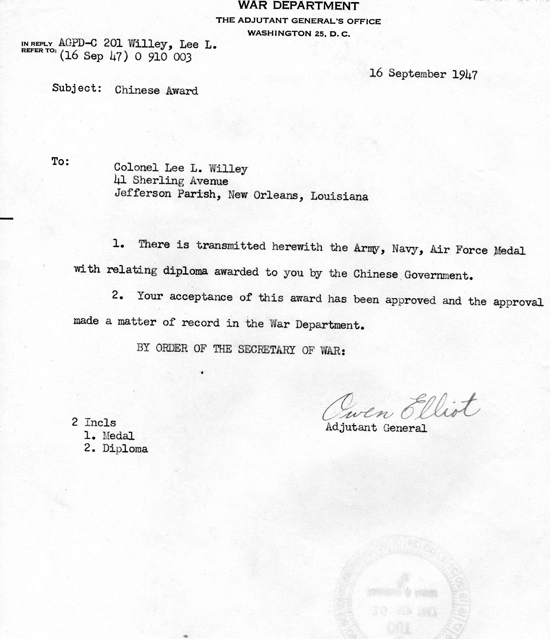 |
Below, a casual view of Willey in the China-Burma-India (CBI) Theater. You can see clearly the ATC pin on each shoulder epaulette (nearest his neck). And on his left shoulder is the CBI patch
Lee Willey, India, Last Half of 1945
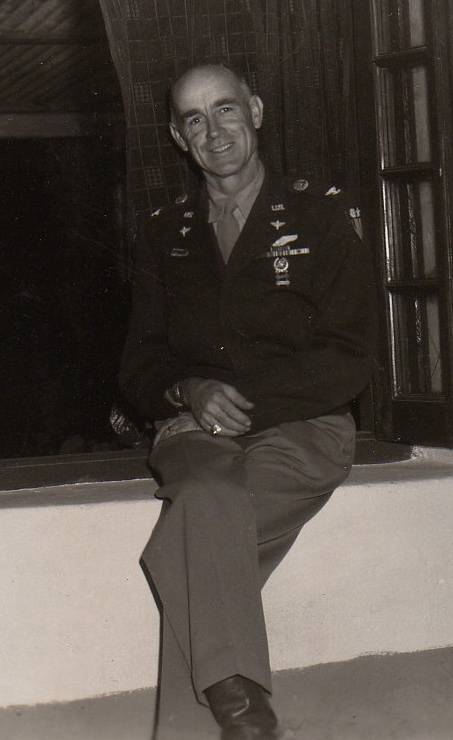 |
Scott Willey's Service Cap With Vintage Sterling Eagle
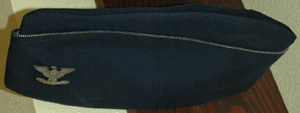 |
Page contibutor and grandson Scott Willey says of the image above, "The eagle on his left shoulder is the one I wore on my flight cap from 1990-95. It was not exactly the same design as the modern USAF eagles, but no one ever noticed it. It's hanging here in my office next to my ... service cap. When Grandma gave me those eagles decades ago, I swore that if I ever made colonel, I'd wear Grandpa Lee's (but only on the flight cap--they would have been too noticeable on my blouse)." Further, " ... the eagle is sterling silver. You don't pick those up in the BX these days!"
Testimonial for Lockheed Constellation
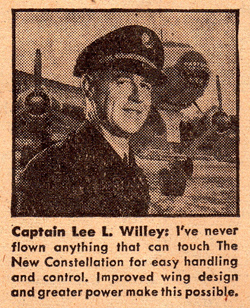 |
After his discharge from the military, he resumed work with Eastern Airlines (ca. August, 1946) and stayed until September, 1950. At left, he provided testimony for the Lockheed Constellation. After World War II, the Constellation became a popular, fast, civilian airliner. Although it was introduced by Lockheed in 1943, because of the immediacy of the war, about two dozen wartime airframes were built as the military C-69 and used for long-distance troop transport.
As of October 23, 1949 he had accumulated 17,000 flight hours. On November 15, 1949 he became the 20th Eastern Air Lines pilot given the Hat-in-the-Ring pin by Eddie Rickenbacker. In September, 1950 he resigned from Eastern and went to work for the F.J. Buirgy Construction Co., Denver CO. Lee Willey passed away May 26, 1952 at St. Mary’s Hospital, Grand Junction, CO.
---o0o---
Below, a series of images that summarize Lee Willey's air transport career. Thanks to his family (right sidebar) we have these significant artifacts to exhibit from each of the minor and major airline companies he worked for. The Aero Corporation of California conferred wings on each of its pilots. Below is a bracelet made from Willey's, as worn by his wife, Gladys. Paul Richter's daughter, Ruth, corroborates the ACC wings design, as she still owns her father's. Back to TOP.
Aero Corporation of California (ACC) Wings, Ca. Late 1920s
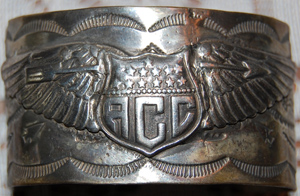 |
Below, three views of a braclet made for Gladys out of Lee Willey's Western Air Express (WAE) pilot wings. Compare this with the charm bracelet made by early Standard Air Lines colleague Hap Russell for his wife.
Western Air Express Service Wings
 |
I am not sure what the "18" means, unless it is the number of the Contract Air Mail (CAM) route that operated in the west. For sure, WAE operated CAM-4, but maybe subcontracted for CAM-18. Does anyone KNOW?
Western Air Express Service Wings, Left View
 |
Western Air Express Service Wings, Right View
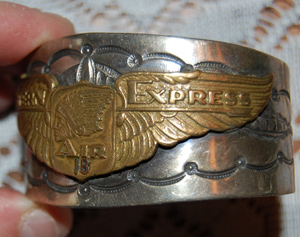 |
Lee Willey's Transcontinental & Western Air Cap Insignia, Ca. 1930
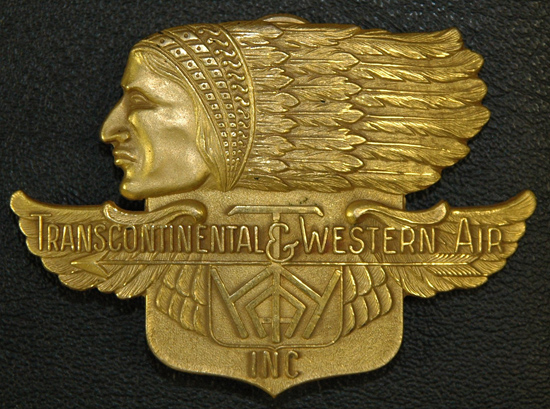 |
Above, a glorious example of the cap insignia from Transcontinental & Western Air, worn by Lee Willey during the early 1930s. Back to TOP.
The Eastern Airlines logo in the letterhead of this Christmas note, below, represents Willey's tenure with Eastern from the early 1930s through 1942 and after the war. The letter was written to him and signed by Eastern President, Eddie Rickenbacker.
At the time of this letter, Willey would have been serving with the 20th Bombardment Squadron as check-pilot on B-29s. The address is that of his parents at the time, which was probably the only "permanent" address he had for the duration of WWII.
Christmas, 1943, Letter from Eddie Rickenbacker
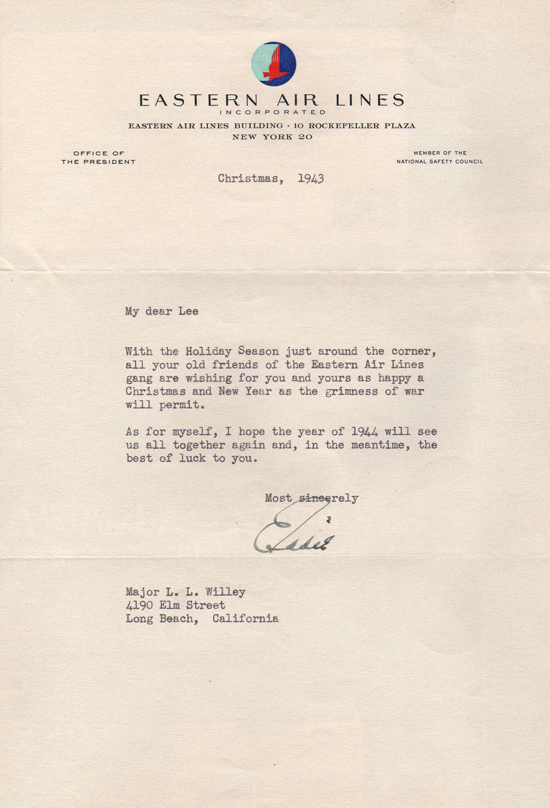 |
Envelope For 1943 Rickenbacker Christmas Letter
 |
Below, a photograph taken from the cockpit of a (probably) DC-2. This was at best a very hazy day. EAL can be made out on the top fo the port wing. Note Willey's name embossed in the upper left of the photo.
Left Wing and Engine of EAL Douglas Transport, Early 1930s
 |
---o0o---
The following two items from the Willey's collections are undated. First, is what appears to be an aircraft clock. with knurled rim and bezel wind, with screw tabs for mounting on a dashboard. The hands and numerals appear to be radium-painted. This clock still runs!
Aircraft Chronometer, Source and Date Unknown
 |
Below, is a WWII-era compass, manufactured by Longines Wittnauer for the US Air Force (actually USAAC) in 1941. On the cover of the nickel case case is stamped "U.S."
Lee Willey's WWII Pocket Compass
 |
---o0o---
Finally, below, a tabulation provided by his family of the civil, commercial and military aircraft types that Lee Willey is known to have flown. We can add to this list the Stearman C-3B that he flew to Tucson September 12 and October 26, 1929. From a newspaper article or two, it is fairly certain that Willey also flew the Fokker Super Universal, especially when he was with Midcontinent Air Express.
Alexander Eaglerock
Beech AT-10 Navigator
Beech AT-11 Kansan
Boeing B-17 Flying Fortress
Boeing B-29 Superfortress
Brewster A-34 Buccaneer
Cessna UC-78 Bobcat
Consolidated B-24 Liberator
Consolidated C-87 Liberator Express
Curtiss A-25 Shrike
Curtiss Condor
Curtiss C-46 Commando
Curtiss JN-4 Jenny
Douglas A-20 Havoc
Douglas A-24B Dauntless
Douglas B-18 Bolo
Douglas C-47 Skytrain
Douglas C-54 Skymaster
Douglas DC-2
Douglas DC-3
Douglas DC-4 (C-54)
|
Fokker (Atlantic) XI Universal
Fokker XII
Lockheed Constellation
Martin A-23 Baltimore
Martin B-26 Marauder
Lockheed AT-18 Hudson
Lockheed UC-60 Lodestar
Lockheed C-57 Lodestar
Lockheed C-60 Lodestar
Lockheed P-38 Lightning
Noorduyn AT-16
North American AT-6 Texan
North American B-25 Mitchell
North American P-51 Mustang
Northrop A-17
Spartan C-71 Executive
Standard J-I
Stearman AT-15
Stinson C-81 Reliant
Thomas Morse Scout
Thunderbird Aircraft Thunderbird W-14
Vultee BT-13 Valiant |
---o0o---
Dossier 2.1.188
THIS PAGE UPLOADED: 03/02/09 REVISED: 07/08/09, 05/13/11, 01/03/12, 06/22/12
|































































